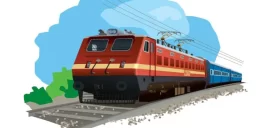On December 20, 2010, IR switched to a system of 5-digit numbers that are supposed to be used for all passenger trains across its system.
The first digit
In the 5-digit train numbering scheme, the first digit indicates the type of the passenger train, as follows:
0 is for special trains (e.g., summer specials, holiday specials, etc.)
1 is for all long-distance trains, including the Rajdhani, Shatabdi, Jan Sadharan, Sampark Kranti, Garib Rath, Duronto, and other classes.
2 is also for long-distance trains; it is to be used when train numbers starting with 1 are exhausted in any series.
3 is for Kolkata suburban trains.
4 is for suburban trains in Chennai, New Delhi, Secunderabad, and other metropolitan areas.
5 is for passenger trains with conventional coaches
6 is for MEMU trains
7 is for DMU (DEMU) and railcar services.
8 is currently reserved
9 is for Mumbai area suburban trains
Second and later digits
ये भी पढ़े – लिवर की बीमारी होने से पहले शरीर से मिलते हैं ये 7 संकेत…
The significance of the second and later digits depends on what the first digit is. Below, the different number series are explained, based on the first digit.
0, 1, 2: In the case of special trains, and long-distance express trains, i.e., trains starting with digits ‘0’, ‘1’, or ‘2’, the remaining 4 digits signify the railway zone and division exactly as in the pre-2011 4-digit scheme. In fact, most 5-digit numbers for long-distance trains as of this writing [4/11] are created simply by prefixing ‘1’ to the former 4-digit codes. See below for an explanation of the 4-digit system. The zonal codes (second digit) are shown below:
0 is for Konkan Railway
1 is for CR, WCR and NCR(?)
2 is for superfasts, Shatabdi, Jan Shatabdi, and some other classes of trains regardless of zones. For these, the next digit is usually the zone code.
3 is shared by ER and ECR
4 is for NR, NCR and NWR
5 is shared by NER and NFR
6 is for SR and SWR
7 is shared by SCR and SWR
8 is for SER and ECoR
9 is for WR, NWR and WCR
For other classes of trains, the remaining digits are used in a few different ways.
3: For Kolkata suburban trains starting with digit ‘3’, there are two sets of numbers, depending on the zone that operates the services.
30xxx through 37xxx : trains run by ER
38xxx through 39xxx : trains run by SER
4: For suburban trains other than in Mumbai and Kolkata, the following conventions apply.
40xxx through 44xxx : Chennai area suburban trains
45xxx through 46xxx : Delhi area suburban trains
47xxx : Secunderabad suburban trains
48xxx through 49xxx : reserved
5, 6, 7: For trains starting with ‘5’, ‘6’, and ‘7’, i.e., passenger trains, the second digit determines the zone as for long-distance trains and the third digit determines the division (see above for zones, or see below for a more detaild list with zone and division codes).
9: Mumbai suburban trains use the following system. Up and down directions are generally reflected in the use of odd and even numbers, respectively.
90xxx: WR locals originating from Virar
91xxx: WR locals originating from Vasai Road / Bhayander
92xxx: WR locals originating from Borivali
93xxx: WR locals originating from Malad / Goregaon
94xxx: WR locals originating from Andheri / Bandra / Mumbai Central
95xxx: CR fast locals
96xxx: CR locals going north of Kalyan
97xxx: CR locals on the Harbour line
98xxx: CR locals on the trans-Harbour line
99xxx: CR locals going south of Kalyan
Please see the explanation of the 4-digit numbering system in use prior to 2011, to understand the structure of the last 4 digits of 5-digit long-distance train numbers, and for the zone/division number assignment for other classes of trains.
Source – IFRCA.org
This entry was posted in 2 Railway Employee, Railway General Information, Railway Employee











